In addition, on Saturday, February 5 and Sunday, February 6, the “Japanese Technology EXPO” was held at the Tokyo International Forum. We will exhibit and screen videos about “the skills of traditional architects”.
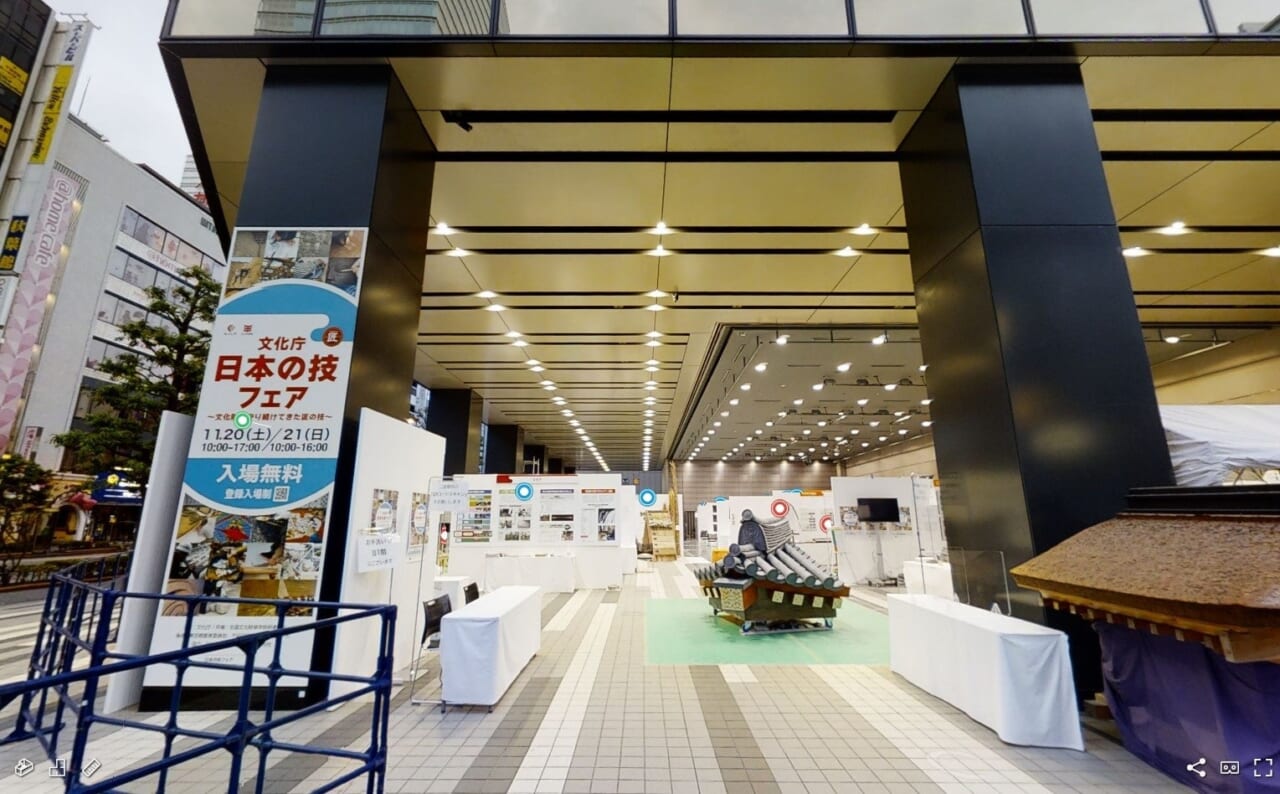
- What is the Agency for Cultural Affairs Japan’s Technology Fair – Craftsmanship that has continued to protect cultural properties?
In recent years, as the living environment has changed, it has become difficult to train traditional techniques and skills, which are indispensable for the preservation of cultural properties, and to train traditional people and secure raw materials.
For this reason, the Agency for Cultural Affairs selects such “cultural property preservation technology” that needs to be taken for preservation as “selection preservation technology”, and is working to preserve and pass on these techniques.
The Japanese art fair is held every year with the aim of contributing to the importance of cultural property preservation technology, training of legends, repair of cultural properties, understanding of the current situation related to raw materials and tools, etc., and contributing to the expansion of future legends and understanding people through exhibitions, demonstrations, and experiences.
The november 2021 fair, which was held for the first time in two years due to the spread of the new coronavirus infection, was held for the first time in Tokyo, and although no experience was held to prevent infection, 34 selected preservation technology preservation organizations exhibited panels and tools and demonstrated the skills of engineers, and it was crowded with many visitors.
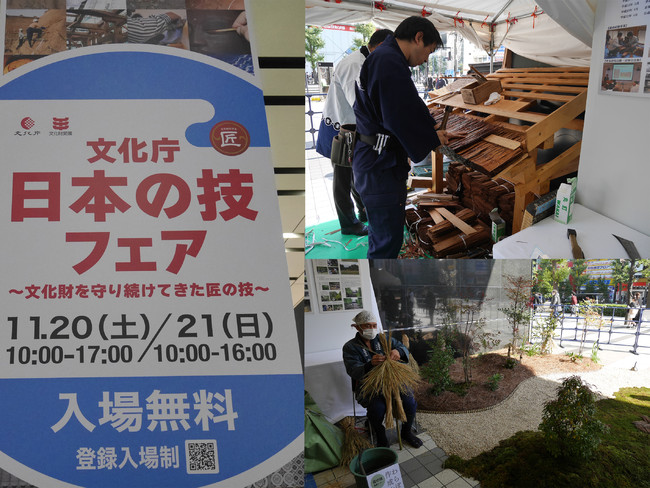
○The upper right: “Hiwedabaki”, Lower right: “Winter’s shitsure Shikimatsuba and Waraboshi”
- At the Tokyo event in November 2021, 34 participating organizations exhibited and demonstrated Japanese techniques.
The venue was an outdoor space that touched the road, so I was able to see people passing by stopped and looked inside with interest.
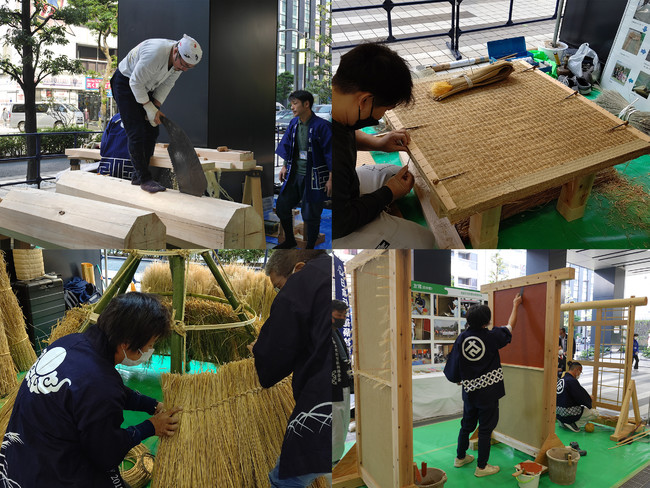
○The upper left: “Daikanna shaving, Yari-maki”, upper right: “Traditional tatami production”, lower left: “Tomakomi , Tomaki”, lower right: “Top coat (white plaster, ocher’s soil, red clay finish)”
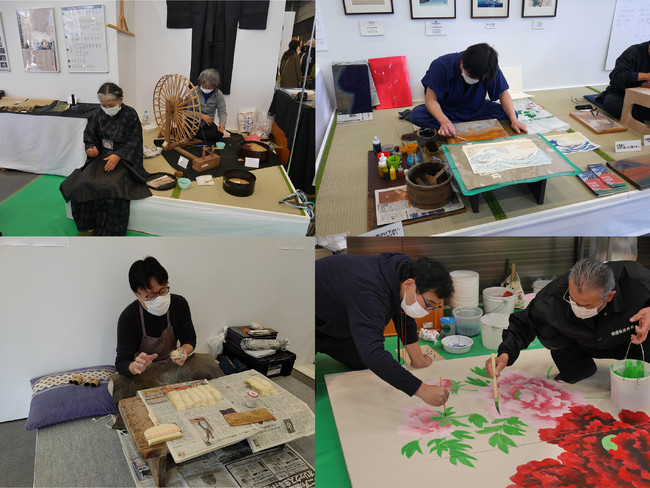
○The upper left: “Twisting with a spinning wheel”, Upper right: “Printing and carving edo woodblock prints”, Lower left: “Production of brushes for tableware”, lower right: “Drawing hanamaru (kabuki large tools (background painting)”
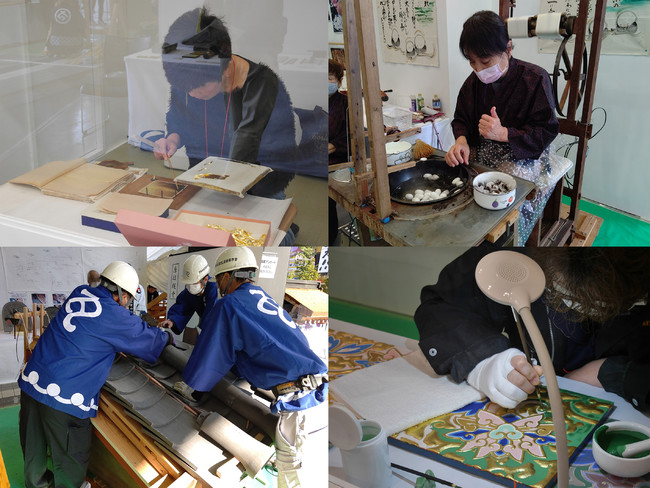
○The upper left of the photo: “Border gold leaf depression”, upper right: “Yarn removal that spins yarn from the cocoon”, lower left: “Hon-tiled”, lower right: “Pasting and coloring gold leaf”
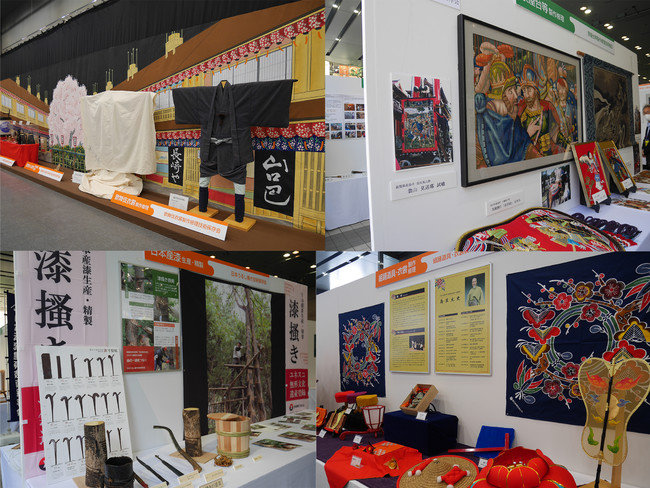
○The upper left: Kabuki costume production repair, upper right: production repair of festival stalls, etc., lower left: Japanese lacquer production and refining, lower right: Ryukyu Indigo Manufacturing
- Experience the 2021 Tokyo Fair in a virtual space!
A site has opened a virtual space that reproduces the state of the 2021 fair using a 3D technology matter port. You can move around the virtual venue like a real venue and enjoy demonstrations and exhibitions held in various places with videos and images.
“Agency for Cultural Affairs Japan’s Technical Experience Fair Virtual Venue”
https://my.matterport.com/show/?m=Bu7qpZVqPzg

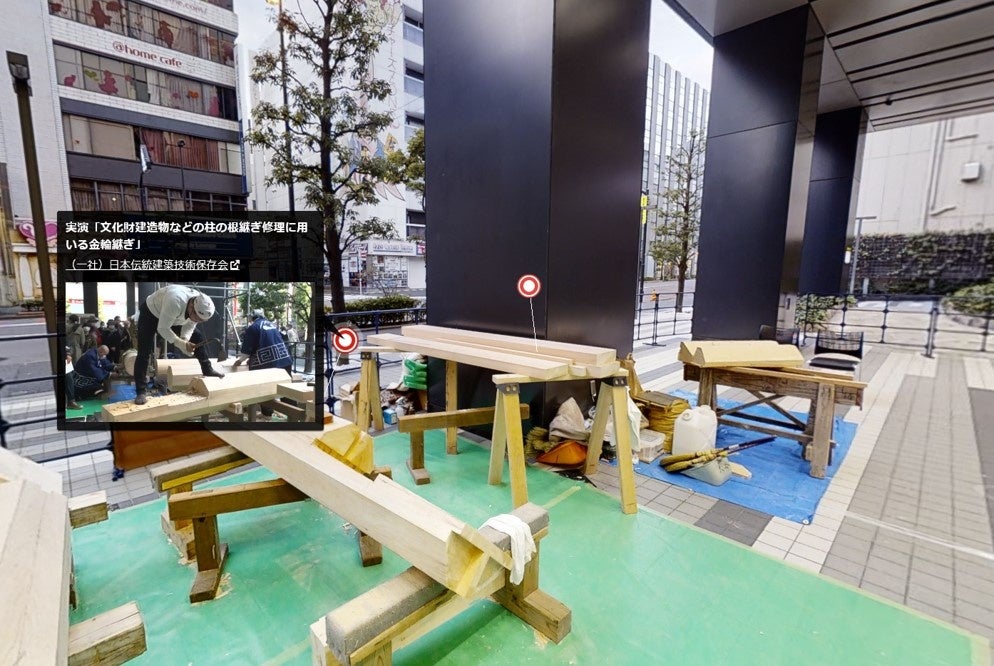
- Gallery Exhibition “Japanese Art EXPO – Natural Materials and Craftsmanship to Protect Cultural Properties” Gallery Exhibition
On Saturday, February 5 and Sunday, February 6, the “Japanese Technology EXPO” was held at the Tokyo International Forum. We will exhibit and screen videos about “the skills of traditional architects”.
Japanese Technique EXPO – Natural Materials and Takumi Techniques to Protect Cultural Properties –
Venue: Lobby Gallery, Tokyo International Forum
Date: Saturday, February 5, 2022, 10:00-17:00
Sunday, February 6, 2022, 10:00-16:00
Admission: Free
For details, please check from the following URL.
https://www.nippon-no-waza.jp/expo/outline.php
- Selection and certification of “selected preservation technology”
Cultural assets are important heritages built by our predecessors, and we have a serious responsibility to preserve them and pass them on to future generations. Under the Act on the Protection of Cultural Properties, among the traditional techniques or skills that are indispensable for the preservation of cultural properties, “preservation technology of cultural properties” that need to be taken as “selection preservation technology” is selected as “selection preservation technology”, and a system has been established to certify its holders and preservation organizations. This system aims to support cultural properties and protect the important technologies that affect their survival, and is intended to improve technology and train legends to secure engineers, as well as record-making of technologies.
Since the establishment of the system in 1975, selection and certification have been carried out as needed to date, and many efforts have been made to preserve and pass on technology, including the implementation of a tradition training project by holders and preservation organizations. In December 2016, the “Traditional Architecture Craftsman’s Skills: Traditional Techniques for Inheriting Wooden Buildings”, which consists of 17 of the national selection preservation techniques, was registered as a UNESCO Intangible Cultural Heritage for the first time from the selected preservation technology.
As of November 1 Reiwa 2013, the number of selected preservation technologies selected and certified is as follows.
| Selected preservation technology 82 cases | ||
| Number of holders | selected 51 | Number of holders 58 |
| Number of preservation groups selected 39 | Preservation groups 41 organizations (35 organizations) |
(For the above number)
Because preservation organizations have duplicate certifications, ( ) indicates the number of actual organizations. Since the same selection preservation technology has certified the holder and the preservation organization, the total of the holder and the preservation organization does not match the number of selected preservation technology.
- Japanese Technology Fair 2021 Exhibition Selection Preservation Technology and List of Preservation Organizations
(☆ Mark is a UNESCO Intangible Cultural Heritage “Traditional Architecture Craftsman’s Skills” Composition Technology, “Inside the demonstration at the technique fair)
Techniques for preserving tangible cultural properties, etc.
1 Building repair and building woodworking ☆ (Public property) Cultural Property Preservation Technology Association
2 Building Woodworking ☆ (One Company) Japan Traditional Building Technology Preservation Society
“Gold wheel fittings used for rooting repair of pillars such as cultural property buildings” “Taiko shaving, spear shaving”
“Lighting of pillar legs and stone openings when erecting round pillars on natural stones”
3 Building decoration ☆ (one company) Shrine and Temple Building Art Preservation Technology Association
4 Cypress bark and persimmon roof thatch Cypress bark collection Roof plate production ☆ (public corporation) National shrine and temple roof construction technology preservation association
“Cypress Bark Roof”
5 Thatch collection☆ Japan Thatch Culture Association
“Tomako knitting, tomako-roofing”
6 Building coloring Building lacquering ☆ (public property) Nikko Shrine and Temple Cultural Property Preservation Society
“Pasting and coloring gold leaf” “Gold leaf stamping”
7 Roof tile roof (main tile roof) ☆ (one company) Japan Traditional Tile Technology Preservation Society
“Hon-tiled roof”
8 Plasterer (Japan Wall) ☆ National Cultural Property Wall Technology Preservation Association
“Take Komai Scraping for Tea Room” “Medium Coating (Beard, Chiri-mai, Medium Coating)”
“Top coat (white plaster, ocher glue soil, red glue finish)”
9 Manufacture of fittings☆ National Traditional Joinery Technology Preservation Association
10 Tatami Mats☆ Cultural Property Tatami Preservation Society
“Making traditional tatami mats”
11 Repair Technology ☆ (One Company) National Treasure Repair Equipment Federation
“Fill in insect holes”
12 Manufacture of repair materials and tools (one company) Association of traditional technology holders
“Making brushes for tableware”
13 Wooden sculpture repair (public) Art Academy
14 Ukiyo-e Woodblock PrintMaking Technology Ukiyo-e Woodblock Print Engraving Technology Preservation Association
“Printing and Carving Edo Woodblock Prints”
15 Production and repair of festival stalls, etc. Production and repair engineer association for festival stalls, etc.
16 Cultural Property Garden Preservation Technology Cultural Property Garden Preservation Engineer’s Council
“Winter’s Sushi Shikimatsuba and Warabochi”
17 Cultural Property Stone Wall Preservation Technology Cultural Property Stone Wall Preservation Technology Council
Techniques for preservation of tangible cultural properties, etc.
18 Takeshi Production Japan Bamboo Technology Preservation Study Group
“Bamboo processing for making bamboo shoots”
19 Edged gold leaf manufacturing ☆ Kanazawa Gold Leaf Traditional Technology Preservation Society
“Bordered Gold Leaf Change”
20 Charcoal production (same) Traditional craft charcoal production technology preservation association
Techniques for preserving intangible cultural properties, etc.
21 Tamahagane Manufacturing (Public Finance) Japan Art Sword Preservation Association
22 Japanese lacquer production and refining☆ Japan Cultural Properties Urushi Association
23 Japanese lacquer production and refining ☆ Japan Urushi scraping technology preservation association
“Pick-up”
24 Ryukyu Indigo Manufacturing Ryukyu Indigo Manufacturing Technology Preservation Society
25 Awa Ai Manufacturing Awa Ai Manufacturing Technology Preservation Society
26 Production and manufacture of plant dyes (red and purple roots) Japan Folk Craft Technology Preservation Association
27 Handmade Washi Tool Production National Handmade Washi Tool Production Technology Preservation Association
28 Production and pulling of 28 Musushi Production technology preservation association from Showa-mura
29 Hemp Yarn Tyings Miyako Makoto Preservation Society
“Twisting with a spinning wheel”
30 Kabuki costume production repair Kabuki costume production repair technology preservation society
31 Kabuki Large Tools (Background Painting) Production Kabuki Large Tools (Background Painting) Production Technology Preservation Society
“Drawing Hanamaru”
32 Kabuki prop production Kabuki prop production technology preservation society
33 Kumiko Dance tools, costume production repair Kumiko dance tools, costume production repair technology preservation society
“Making Props”
34 Japanese musical instrument raw yarn manufacturing Kinomoto-cho Japanese musical instrument raw yarn manufacturing preservation society
“Yarn taking from cocoons”
Pamphlet, a traditional master who supports cultural assets
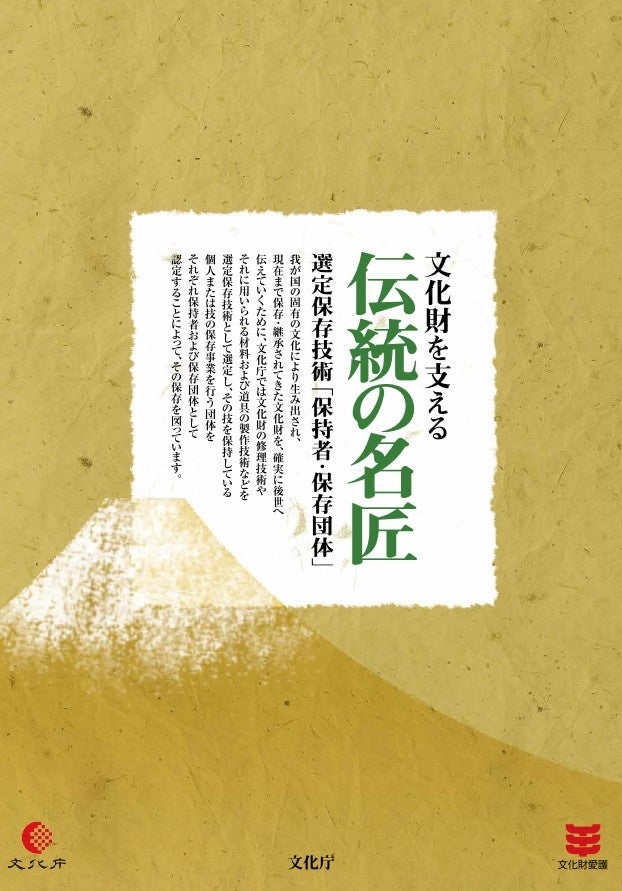
You can download from the following URL
https://prtimes.jp/a/?f=d47048-20220203-6ff9b0a27d26516cd4fef278843173a7.pdf


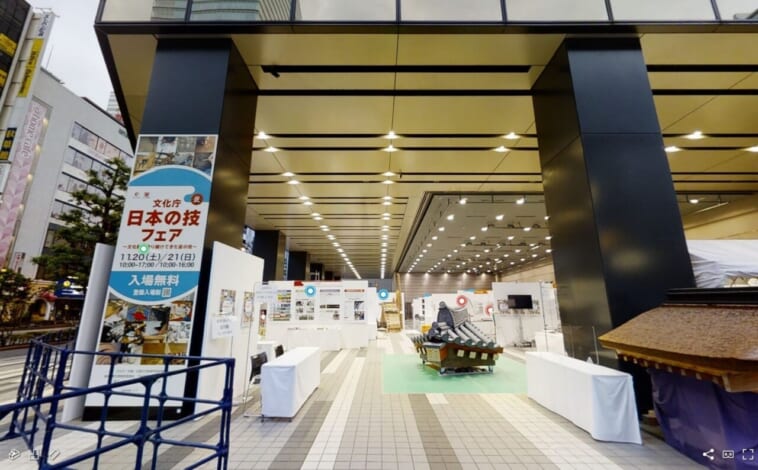






GIPHY App Key not set. Please check settings